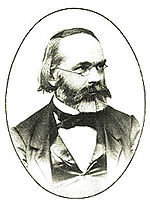- Karl Wilhelm von Nägeli
-
Karl Wilhelm von Nägeli 
Karl Wilhelm von NägeliBorn 27 March 1817 Died 11 May 1891 Nationality Swiss Fields botanist Known for chromosomes Karl Wilhelm von Nägeli (27 March 1817 – 11 May 1891) was a Swiss botanist. He studied cell division and pollination, but became known as the man who discouraged Gregor Mendel from further work on genetics.
Contents
Birth and education
Nägeli was born in Kilchberg near Zurich, where he studied medicine at the University of Zurich. From 1839, he studied botany under A. P. de Candolle at Geneva, and graduated with a botanical thesis at Zurich in 1840. His attention having been directed by Matthias Jakob Schleiden, then professor of botany at Jena, to the microscopical study of plants, he engaged more particularly in that branch of research.
Academic career
Soon after graduation he became Privatdozent and subsequently professor extraordinary, in the University of Zurich; in 1852 he was called to fill the chair of botany at the University of Freiburg; and in 1857 he was promoted to Munich, where he remained as professor until his death.
Contributions
It was thought that Nägeli had first observed cell division during the formation of pollen, in 1842.[1] However, this is disputed by Henry Harris, who writes: "What Nägeli saw and did not see in plant material at about the same time [as Robert Remak] is somewhat obscure... I conclude... that, unlike Remak, he did not observe nuclear division... it is clear that Nägeli did not in 1844 have any idea of the importance of the nucleus in the life of the cell.[2]
In the 1857 that microsporidia where first described by the Nageli. This was due to them being the agent in causing pebrine disease of silkworms which devastated the silk industry in Europe (Texier et al, 2010, p.443).
Among his other contributions to science were a series of papers in the Zeitschrift für wissenschaftliche Botanik (1844–1846); Die neueren Algensysteme (1847); Gattungen einzelliger Algen (1849); Pflanzenphysiologische Untersuchungen (1855–1858), with Carl Eduard Cramer; Beiträge zur wissenschaftlichen Botanik (1858–1868); a number of papers contributed to the Royal Bavarian Academy of Sciences, forming three volumes of Botanische Mitteilungen (1861–1881); and, finally, his volume, Mechanisch-physiologische Theorie der Abstammungslehre, published in 1884. However, perhaps Nägeli is best known nowadays for his unproductive correspondence (1866–1873) with Gregor Mendel concerning the latter's celebrated work on Pisum sativum, the garden pea.
The writer Simon Mawer, in his book Gregor Mendel: planting the seeds of genetics (2006), gives us an interesting and detailed account of Nägeli's correspondence with Mendel. Mawer underlines that, at the time Nägeli was writing to the friar from Moravia, Nägeli "must have been preparing his great work entitled A mechanico-physiological theory of organic evolution (published in 1884, the year of Mendel's death) in which he proposes the concept of the 'idioplasm' as the hypothetical transmitter of inherited characters". Mawer notes that, in this Nägeli book, there is not a single mention of the work of Gregor Mendel. That prompted him to write: "We can forgive von Nägeli for being obtuse and supercilious. We can forgive him for being ignorant, a scientist of his time who did not really have the equipment to understand the significance of what Mendel had done despite the fact that he (von Nägeli) speculated extensively about inheritance. But omitting an account of Mendel's work from his book is, perhaps, unforgivable." (Mawer 2006, p. 81)
References
- ^ Sedgwick. A short history of science. p. 429. http://books.google.com/books?id=qvycs9jqNEQC&pg=PA429.
- ^ Harris, Henry 1997. The cells of the body: a history of somatic cell genetics. Cold Spring Harbor Laboratory, Plainview N.Y. p. 15.
- ^ "Author Query". International Plant Names Index. http://www.ipni.org/ipni/authorsearchpage.do.
 This article incorporates text from a publication now in the public domain: Chisholm, Hugh, ed (1911). "Naegeli, Karl Wilhelm von". Encyclopædia Britannica (11th ed.). Cambridge University Press.
This article incorporates text from a publication now in the public domain: Chisholm, Hugh, ed (1911). "Naegeli, Karl Wilhelm von". Encyclopædia Britannica (11th ed.). Cambridge University Press.
External links
Categories:- Botanists with author abbreviations
- 1817 births
- 1891 deaths
- Phycologists
- People from the canton of Zurich
- Swiss mycologists
- Swiss botanists
- Swiss nobility
- University of Zurich alumni
- University of Zurich faculty
- University of Geneva alumni
- University of Freiburg faculty
- Ludwig Maximilian University of Munich faculty
- Foreign Members of the Royal Society
Wikimedia Foundation. 2010.
